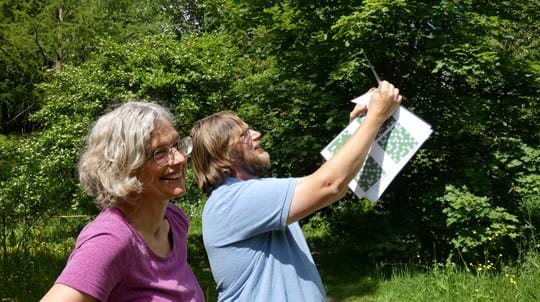
About us

Forest Research
It is only when you look back that you can see the achievements that follow all the work done.
The Observatree volunteers are out there, year after year, looking after trees, sentinel, healthy or diseased ones. Over 13,500 reports have been submitted to date, and step-by-step they are building up an extremely valuable e-resource that will become increasingly useful, informative, and comprehensive. Many of these 13,500 relate to healthy trees and those data are just as important as reports on pests and diseases in helping to illustrate the occurrence of pests or diseases within the wider environment.
During 2021, Observatree volunteers submitted reports on the project’s priority pests and diseases. In fact, 174 reports were submitted to Forest Research as suspected priority pests and diseases last year. These reports were submitted by 48 Observatree volunteers. Most volunteers submitted less than five reports each and four of the volunteers submitted more than ten, with one volunteer submitting 38 reports. Of those, 73% originated from England, 25% from Scotland and 2% from Wales.
Most reports were submitted using TreeAlert (95%) and only a handful reached us by email or post. In total 28 plant genera were reported with ash, oak, elm, and sweet chestnut being at the front line. Looking to these hosts, I am sure you can already guest the pests and disease reported on those. Try it before you continue reading! It is easy now to think of a tree and know the pest or disease affecting them.
On oak, Oak processionary moth (OPM) was the most reported pest, and these data have contributed to the mapping and management efforts of the OPM teams from Forestry Commission (some volunteers also submitted OPM data directly to colleagues within the FC using our OPM app).
On sweet chestnut, reports of the Oriental chestnut gall wasp (OCGW), which was detected in UK in 2015 for the first time, were another great contribution from Observatree volunteers, and these reports help us to understand the distribution of this pest. On elm, almost all the Elm zig-zag sawfly cases received at the Tree Health Diagnostic and Advisory Service (THDAS) this year were submitted by Observatree volunteers. So here is another splendid example of the Observatree contribution to the data and mapping of this pest that was spotted in the UK in 2017.
Regarding diseases, on ash, we had reports of Chalara ash dieback, especially in Scotland in areas where we had no previous records. Therefore, these new locations have contributed to the maps created by Forestry Commission which track the distribution of the disease and are updated on regular basis. Sirococcus blight of cedar was one of the top reported diseases on cedar followed by Mountain ash ring-spot virus and cases of Acute Oak decline (AOD).
Other non-priority pests and diseases have also been reported by Observatree volunteers and these reports are contributing to the bigger picture of tree health in Britain. At the THDAS we are not only interested on the priority pests and diseases but also about the common and the uncommon ones. These reports will help us in time to detect trends, and we are finding out about the changing distributions of these pests and diseases, especially when combined with the healthy tree and sentinel tree data submitted by Observatree volunteers. All the reports are useful and contribute to the bigger picture, so I would like to thank all Observatree volunteers for all their work, time, and effort on submitting the reports.
If there is something that I really miss, it is meeting Observatree volunteers face-to-face. In the last couple of years, many of our project meetings have been online. But this has created other opportunities and my colleague Suzanne Sancisi-Frey created a series of webinars that allowed updates from tree health related work taking place across the Observatree partnership and included presentations by some volunteers on their surveys and findings.
I attended some of these either to present a topic or to listen to Observatree volunteer’s work. I think these events have been a fantastic way to stay connected. I did manage to have a face-to-face meeting with some of our lead volunteers at the end of last year at the Yorkshire Arboretum. This was a wonderful opportunity to meet again and to walk in the Arboretum discussing tree health. I hope that the year ahead will create further opportunities to meet with many of our existing and new volunteers.
So, a big thank you to all Observatree volunteers for all the magnificent work that you continue to do. And for being prepared to support tree health surveillance and research when we need you. Working together makes the journey more enjoyable.